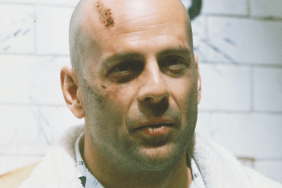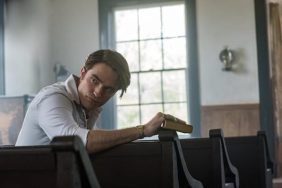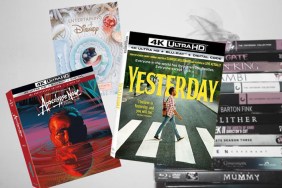Ghost Rider: Spirit of Vengeance is out in theaters this week, although we’re still not entirely sure why. Oh, we like Neveldine/Taylor as much as the next guys – we even think Gamer gets a bum rap – but Ghost Rider’s such a weird superhero to turn into a movie in the first place. There are a lot more B-level superheroes who deserve their own movie. This is, after all, a guy who sold his soul to the devil, and turned into a superhero as a result. For an origin, that’s hazy logic at best, and an outright head-scratcher at worst.
But Ghost Rider wasn’t the first guy to sell his soul to the devil in the movies. There have been depictions of Old Scratch since practically the dawn of the medium. (Hugo star Georges Melies played him all the way back in 1896, in the short film The Haunted Castle.) So this week on Five Great Movies we’re focusing some classic films that feature Satan himself, in funny, scary or just plain funky ways.
As always, we remind you that we’re not claiming these are thebest movies, per se, just five great ones regardless of ranking. If we left out your favorite, let us know in the comments below. Heck, we had to leave out one of our own, since his identity was supposed to be the film’s big final twist. You can probably guess which one that is. (No, not that one. The other one.)
Fantasia (dir. Various, 1940)

Although Disney’s animated movies practically defined the medium early on, it’s important to remember that Walt Disney himself was always experimenting with new ideas. His third feature-length animated movie, after Snow White and the Seven Dwarfs and Pinocchio, was one such experiment. Fantasia was a non-narrative film featuring seven vignettes set to classical music, although one segment, set to Ludwig von Beethoven’s A Pastoral Symphony, has been cut from every version since the 1960’s for its racist imagery. Its depiction of the devil might not be quite as evil as that ruckus, but he’s one of the most iconic depictions of Satan ever placed on film.
Fantasia’s final vignette is Night on Bald Mountain, set to a composition by Russian composer Modest Mussorgsky, based on his own opera The Fair at Sorochynski. The opera was a comedy about a man who makes a bargain with a gypsy to marry the woman he loves, in a town rife with superstition about the devil coming to the annual fair. The actual piece used for Fantasia comes from a dream sequence the hero has about demons and witches dancing, and then scared away by church bells. The Fantasia version is a particularly spectacular interpretation of those events. As the camera settles on the titular mountain, the top of the spire opens up to reveal that it is actually the giant demon Chernabog, later referred to by Walt Disney as “The Devil Himself.” Chernabog calls forth demons and spirits from a nearby cemetery to dance for his amusement before being scared back into the mountain by a church bell. What it lacks in plot, it makes up for in ominous atmosphere.
Although he does little that can be described as actually villainous, Chernabog has an unforgettably demonic presence. Disney’s early films, in particular, masterfully presented monsters like Chernabog and Monstro the Whale in a scale inconceivable by live-action films of the period, and still surpass many giant monster movies of the day. Compare Night on Bald Mountain to Roland Emmerich’s Godzilla, for example, to get an impression of how little modern filmmakers paid attention.
Bedazzled (dir. Stanley Donen, 1967)

These days, Stanley Donen is best remembered for his musicals, like Singin’ in the Rain and On the Town (co-directed with Gene Kelly), but he was a multi-faceted director with a much broader resume. In addition to the classic Hitchcockian thriller Charade and the underrated 1980s sci-fi flick Saturn 3, Donen also directed this deft, subversive take on the old Faust story starring British comedy legends Dudley Moore and Peter Cook. Cook also wrote the screenplay.
Moore stars as Stanley Moon, a mild-mannered restaurant employee in love with his co-worker Margaret (Alfie’s Eleanor Bron). He can’t work up the nerve to confess his feelings, and is about to commit suicide when he is approached by George Spiggott (Cooke), aka the devil himself, who offers him seven wishes in exchange for his soul. George has a bet going with God, you see, and whoever gets 100 billion souls first wins. Stanley keeps wishing for ways to woo Margaret, ranging from being a rock to simply being happily married, but George twists his words to hilarious effect every time. Stanley the Rock Star turns out to be a one-hit wonder, and Margaret the fan girl immediately moves on the next big thing. The happy marriage is undone when Stanley realizes that they’re married to other people. But the best parts of Bedazzled stem from Moore and Cook just hanging out while the devil makes his daily rounds. Cook was a right charming devil.
Bedazzled was remade by Harold Ramis in 2000, starring Brendan Fraser and Elizabeth Hurley in the Moore and Cook roles, respectively. But aside from Hurley’s many, many fetish outfits, it’s an unremarkable adaptation. The original film had Dudley Moore in a nun outfit, celebrating God via trampoline. You just can’t compete with that.
Time Bandits (dir. Terry Gilliam, 1981)

Following the success of the early Monty Python movies, animator and infrequent on-screen presence Terry Gilliam struck out on his own to direct feature films. His first film, Jabberwocky, was made in 1977, but his second feature, Time Bandits, became his early calling card. It’s a wonderfully cynical children’s adventure about a young boy named Kevin (Craig Warnock), who winds up on a time-traveling adventure with a group of little people on the run from God. Just to clarify, this is a kids movie, even though it’s dark and subversive as all hell.
Speaking of Hell, the main antagonist of the film is “Evil,” portrayed by the inimitable David Warner (a career villain, who also menaced the screen in TR0N and Time After Time). Evil wants to use a map the Time Bandits have stolen in order to remake the universe in his own image. An example: “If I were creating the world I wouldn’t mess about with butterflies and daffodils. I would have started with lasers, eight o’clock, day one!”
Gilliam’s films often portray consumerism and bureaucracy as a moral antithesis to hopeful daydreamers. You can certainly find other examples in Brazil and The Adventures of Baron Munchausen, the other installments in his so-called “Trilogy of Imagination.” Evil’s henchmen are plastic-wrapped, just like the furniture in Kevin’s parents’ house, who strive to preserve their purchases whilst simultaneously negating their actual value in the home. And in true Gilliam fashion, not only is evil defeated at the end of the film, but Kevin’s parents as well, in one of the most vicious moments ever intended for young audiences.
Prince of Darkness (dir. John Carpenter, 1987)

Many of John Carpenter’s films have become genre classics, from Halloween to They Live, but during his most prolific and acclaimed period he also directed the generally unappreciated intellectual horror film Prince of Darkness. Critics hated it, audiences tend to consider it one of the Master of Horror’s lesser films (if not one of his worst), but they all need to give it another look. Prince of Darkness is a rich, complex and frightening take on religious myths, even if it does have Alice Cooper stabbing a guy to death with a bicycle.
The film opens when the Catholic Church discovers a secret catacomb beneath one of its oldest churches in Los Angeles. A vicar (Donald Pleasance) is tasked with investigating the find, and enlists the aid of a physics professor (the wonderful Victor Wong) and his students to research a canister of a mysterious liquid. Prince of Darkness places these skeptics into a situation where the laws of physics no longer apply, but also one in which the concept of evil itself can be scientifically quantified. It’s easy to criticize the film for making little sense, but that’s entirely the point. In an utterly Lovecraftian fashion, Carpenter’s film defies the traditional horror notion of defining its supernatural with rules, making its protagonists seem terrifyingly helpless, and raising the stakes beyond the typical apocalyptic movie, even though the events are confined to a dilapidated old church. Carpenter’s score keeps the events pushing forward, connecting disparate storylines through their sheer narrative drive: every action brings the end of the world ever closer, no matter how insignificant. If you’ve written off John Carpenter’s Prince of Darkness, like we once did, we urge to to give it another gander, and actually enjoy the director’s efforts to defy your expectations.
South Park: Bigger, Longer and Uncut (dir. Trey Parker, 1999)

The year was 1999, and the creators of South Park just wanted to make a little movie. It was a musical, inspired by Broadway shows and Disney classics. It was also a foul-mouthed, utterly offensive commentary on their own show’s popularity, which attempted to diffuse criticisms about its subject matter by subjecting two television stars – Canada’s Terence and Philip – to the same level of demonization the pair expected to receive for their own efforts. Not everyone got the joke, but those who did were treated to what turned out to be one of the most insightful social commentaries of in years.
Oh, and the Devil’s in a gay, emotionally abusive relationship with Saddam Hussein. That’s kind of why we’re talking about it.
Yes, this version of Satan is an emotionally needy dreamer who just dreams of being “Up There,” as he’s fond of singing, and needs the world to embrace the evils of intolerance and censorship to bring forth his reign. He doesn’t realize, though, that his boyfriend, who wants the world for himself, is actually using him. It’s a delightful subversion of the usual “all powerful” motif that you’ll find in most depictions of the devil, and typical of South Park’s trademarked disregard for narrative conventions. At least, everyone else’s narrative conventions. There’s a reason why, “You know, I Learned Something Today” has become a bit of a joke. This version of Satan has made multiple appearance on the South Park show proper, and has officially entered the pop culture lexicon.
That’s it for Five Great Movies this week. Come back next Wednesday for another installment, and until then, let us know what you’re favorite cinematic depiction of Satan is!








